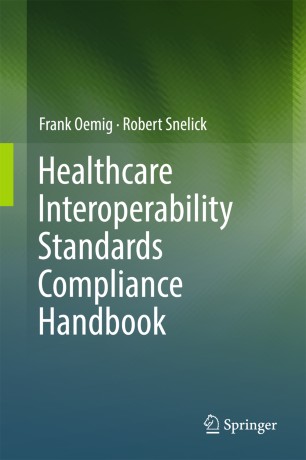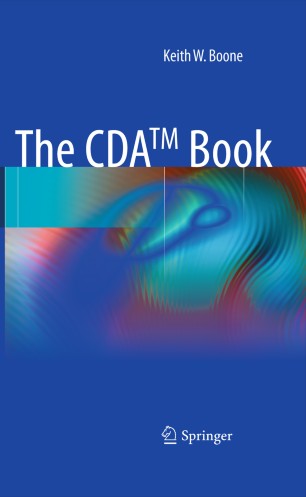Book Recommendations

Braunstein: Health Informatics on FHIR: How HL7's New API is Transforming Healthcare
Hardcover: 341 pages
Publisher: Springer; 1st ed. 2018 edition (August 6, 2018)
Language: English
ISBN-10: 3319934139
ISBN-13: 978-3319934136
This textbook begins with an introduction to the US healthcare delivery system, its many systemic challenges and the prior efforts to develop and deploy informatics tools to help overcome those problems. It goes on to discuss health informatics from an historical perspective, its current state and its likely future state now that electronic health record systems are widely deployed, the HL7 Fast Healthcare Interoperability standard is being rapidly accepted as the means to access the data stored in those systems and analytics is increasing being used to gain new knowledge from that aggregated clinical data. It then turns to some of the important and evolving areas of informatics including population and public health, mHealth and big data and analytics. Use cases and case studies are used in all of these discussions to help readers connect the technologies to real world challenges.
Effective use of informatics systems and tools by providers and their patients is key to improving the quality, safety and cost of healthcare. With health records now digital, no effective means has existed for sharing them with patients, among the multiple providers who may care for them and for important secondary uses such as public/population health and research. This problem is a topic of congressional discussion and is addressed by the 21st Century Cures Act of 2016 that mandates that electronic health record (EHR) systems offer a patient-facing API.
HL7's Fast Healthcare Interoperability Resources (FHIR) is that API and this is the first comprehensive treatment of the technology and the many ways it is already being used. FHIR is based on web technologies and is thus a far more facile, easy to implement approach that is rapidly gaining acceptance. It is also the basis for a 'universal health app platform' that literally has the potential to foster innovation around the data in patient records similar to the app ecosystems smartphones created around the data they store. FHIR app stores have already been opened by Epic and Cerner, the two largest enterprise EHR vendors.
Provider facing apps are already being explored to improve EHR usability and support personalized medicine. Medicare and the Veteran's Administration have announced FHIR app platforms for their patients. Apple's new IOS 11.3 features the ability for consumers to aggregate their health records on their iPhone using FHIR. Health insurance companies are exploring applications of FHIR to improve service and communication with their providers and patients. SureScripts, the national e-Prescribing network, is using FHIR to help doctors know if their patients are complying with prescriptions.
This textbook is for introductory health informatics courses for computer science and health sciences students (e.g. doctors, nurses, PhDs), the current health informatics community, IT professionals interested in learning about the field and practicing healthcare providers. Though this textbook covers an important new technology, it is accessible to non-technical readers including healthcare providers, their patients or anyone interested in the use of healthcare data for improved care, public/population health or research.

Oemig/Snelick: Healthcare Interoperability Standards Compliance Handbook: Conformance and Testing of Healthcare Data Exchange Standards
Hardcover: 662 pages
Publisher: Springer; 1st ed. 2016 edition (December 20, 2016)
Language: English
ISBN-10: 3319448374
ISBN-13: 978-3319448374
This book focuses on the development and use of interoperability standards related to healthcare information technology (HIT) and provides in-depth discussion of the associated essential aspects. The book explains the principles of conformance, examining how to improve the content of healthcare data exchange standards (including HL7 v2.x, CDA, and FHIR), the rigor of conformance testing, and the interoperability capabilities of healthcare applications for the benefit of healthcare professionals who use HIT, developers of HIT applications, and healthcare consumers who aspire to be recipients of safe and effective health services facilitated through meaningful use of well-designed HIT.
Readers will understand the common terms interoperability, conformance, compliance and compatibility, and be prepared to design and implement their own complex interoperable healthcare information system. Chapters address the practical aspects of the subject matter to enable real-world application of previously theoretical concepts. The book provides real-world, concrete examples to explain how to apply the information, and includes many diagrams to illustrate relationships of entities and concepts described in the text.
Designed for professionals and practitioners, this book is appropriate for implementers and developers of HIT, technical staff of information technology vendors participating in the development of standards and profiling initiatives, informatics professionals who design conformance testing tools, staff of information technology departments in healthcare institutions, and experts involved in standards development. Healthcare providers and leadership of provider organizations seeking a better understanding of conformance, interoperability, and IT certification processes will benefit from this book, as will students studying healthcare information technology.

Benson/Grieve: Principles of Health Interoperability: SNOMED CT, HL7 and FHIR
Series: Health Information Technology Standards
Paperback: 445 pages
Publisher: Springer; 3rd ed. 2016 edition
Language: English
ISBN-13: 978-3-319-30368-0
This book provides an introduction to health interoperability and the main standards used. Health interoperability delivers health information where and when it is needed. Everybody stands to gain from safer more soundly based decisions and less duplication, delays, waste and errors.
The third edition of Principles of Health Interoperability includes a new part on FHIR (Fast Health Interoperability Resources), the most important new health interoperability standard for a generation. FHIR combines the best features of HL7's v2, v3 and CDA while leveraging the latest web standards and a tight focus on implementability. FHIR can be implemented at a fraction of the price of existing alternatives and is well suited for use in mobile phone apps, cloud communications and EHRs.
The book is organised into four parts. The first part covers the principles of health interoperability, why it matters, why it is hard and why models are an important part of the solution. The second part covers clinical terminology and SNOMED CT. The third part covers the main HL7 standards: v2, v3, CDA and IHE XDS. The new fourth part covers FHIR and has been contributed by Grahame Grieve, the original FHIR chief.

Boone: The CDA Book
Hardcover: 307 pages
Publisher: Springer; 2011 edition (May 25, 2011)
Language: English
ISBN-10: 0857293354
ISBN-13: 978-0857293350
Clinical documentation is used throughout healthcare to describe care provided to a patient, communicate essential information between healthcare providers and maintain medical records. The CDA Book describes the HL7 Clinical Document Architecture Release 2.0 standard, a standard format for clinical documentation. It is thus intended for Healthcare Informaticists and IT developers, analysts and architects developing Healthcare applications working with all types of clinical documents.
"The Clinical Document Architecture (CDA) is a common container for assembly of structured and unstructured information that does not require creating numerous standards for individual document types. What has been missing to date is the educational materials to make CDA accessible to everyone. This book contains the documentation, samples, and guidance needed to successfully implement CDA in real world applications. It will accelerate adoption of CDA as a means to exchange structured data elements that not only capture the thought process of the encounter for care coordination but also can be stored as individual data elements for population health, research, and decision support." John D. Halamka MD, Chief Information Officer at Harvard Medical School